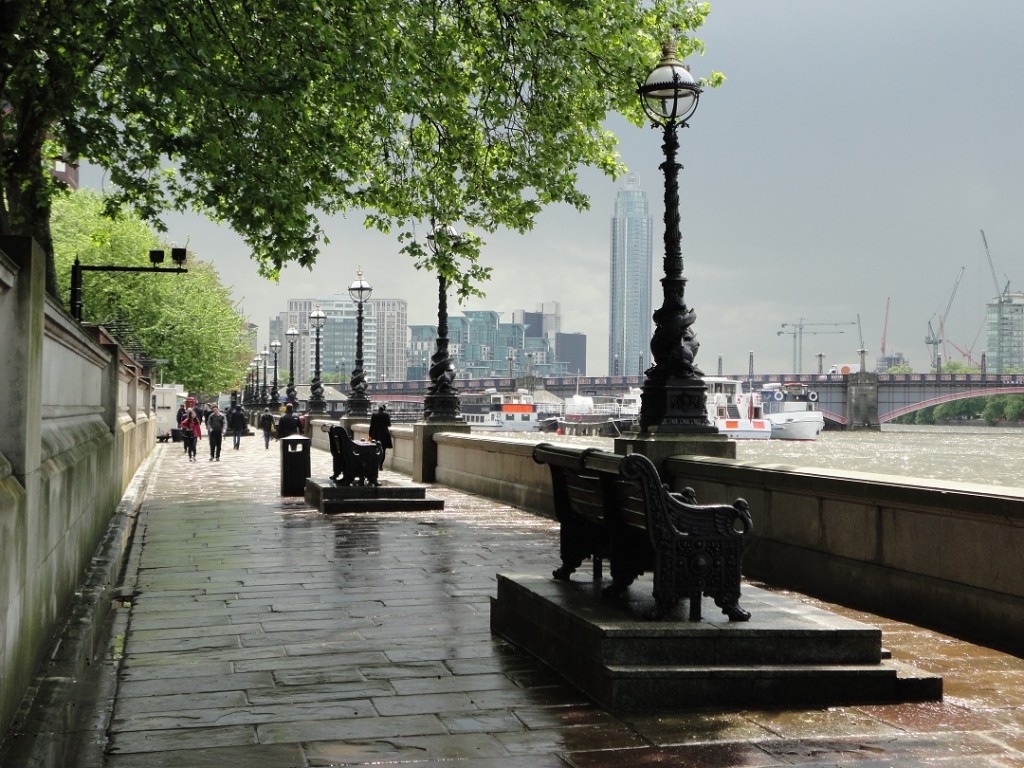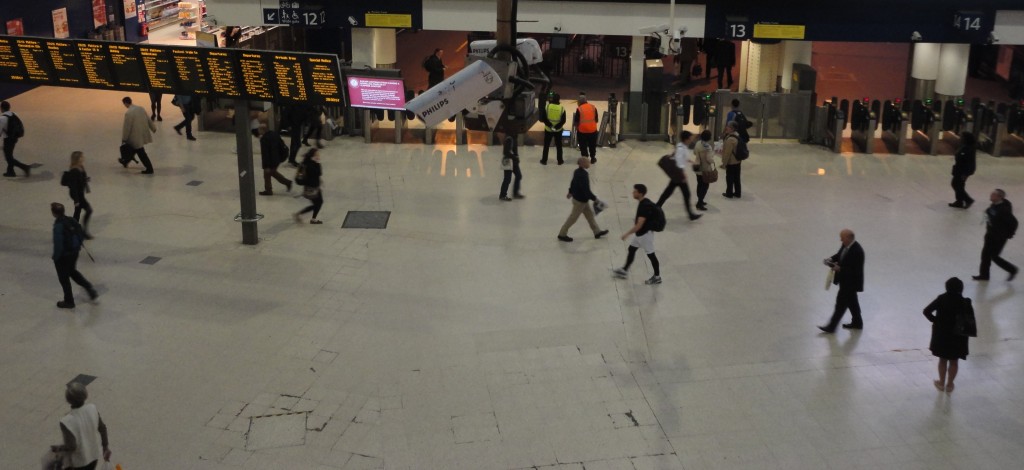The UK uses surveillance cameras like a comfort blanket, with some care homes for the elderly planning to install them in bedrooms. Rather than arguing about security versus privacy, we should be more discriminating.
Originally published on Beacon.
One recent morning, travelling from home in West Oxfordshire to the office in London, I counted the number of surveillance cameras I passed. There were a couple on the roadside, a few more in the garage recording the numberplates of those buying fuel, one on the bus to the station, six at the station. None on the train, but it’s an old model.
Things really kicked off in London. I passed 40 at Paddington train station; the capital’s stations have been festooned with badly retrofitted cameras in recent years, as the header image taken at Waterloo shows. There were 13 more in the tube station, 15 when changing lines at Oxford Circus, a couple more in the second tube train (newer model than the first), 11 at Vauxhall tube station then 17 more on a 10-minute walk to the office. In total, I counted 110 cameras on my way into work. I probably missed a few.
Surveillance cameras have become a part of the environment of British cities and towns, probably more so than in other free countries: the best estimate is that there are around 1.85m, but no-one really knows. However, if you compare an urban British street or train platform to its equivalent in continental Europe, you will generally see a lot more cameras. They are usually called CCTV, for closed-circuit television, as distinct from broadcast television cameras.
In fact, CCTV is used to make a lot of broadcast TV. Programmes such as Cops with cameras and CCTV cities use camera footage to brighten up what would otherwise be a lot of police officers sitting in studios recounting their greatest arrests. Rather more importantly, such output is frequently used in court as evidence. The vast majority is half-watched by someone sitting in front a bank of screens or never seen at all, then left on a hard-drive until it is deleted.

Surveillance cameras are ugly in almost any setting. Older ones, along with the specialist sort used for vehicle numberplates, are usually inside some kind of round or boxy tube. Newer ones have the camera inside a darkened dome, which looks like an enormous lens. (The camera is inside, the idea is you can’t see where it’s pointing.) At best, these look like blown-out light bulbs. And running all these cameras costs a lot of money. Big Brother Watch, a privacy campaign group, found in 2012 that Britain’s councils (which run most of those watching streets) spent £515m over four years on their 51,600 cameras – and that usage varies enormously, even between similar areas. The island groups of Shetland and Orkney, with similar populations of around 20,000 people, had 210 and 14 council cameras respectively.
Cameras are meant to create security. Obviously, unlike a police officer, a security guard or another human, a camera can’t stop anything happening – it can only record. Someone may or may not be watching them; you don’t know. The camera may or may not be working, or in the case of the dark-dome ones may or may not be pointing at you being mugged; you don’t know that either. The idea is that the potential mugger doesn’t know that it’s not working, pointing in his direction and being watched live by an eagle-eyed operator ready to call the cops; or even if unnoticed at the time, that the footage might later be retrieved from a hard disk and used in court to send him down. But as May 2005 made all too obvious, the 13,500 cameras on the London Underground system can’t stop a determined bomber.
In genuinely insecure cities, physical barriers and security guards are used. Britain’s enthusiasm for cameras seems to be a combination of it being a pretty safe place (with one murder per 100,000 people in 2011 according to the UN Office on Drugs and Crime, compared to 4.7 in the US and 30 in South Africa) that is overly scared of crime. The British public like to see ‘bobbies on the beat’ (police officers walking around), but this it is expensive way to reassure people. From an efficiency point of view in a time of falling police budgets, far better to have officers focusing on actual reported crimes, and use cameras to do the reassurance.
The idea that cameras are at least partly there as a security comfort blanket is reinforced by the new uses that Britain is finding for them. Recently, following a series of scandals over care homes for the elderly, one chain said it would offer the option of cameras in bedrooms, to track abuse. This is based on a very small number of cases of abuse in such homes, highlighted by the BBC Panorama programme using hidden cameras in abusive care homes.
The main argument against surveillance cameras is that they invade people’s privacy. While I am sympathetic to this, it’s an argument that gets used a bit too much. Camera footage is not structured data about people’s movements; it needs humans to watch it to map where someone has been and who they have talked to. In theory, facial recognition software could join all this footage up, but in reality it is far from reliable. If you want to track someone, you will find out much more from the metadata produced by mobile phones, which tells you who they contacted as well as where they went to a high degree of certainty. This is certainly what the police and spies prefer to use.
Sometimes, the privacy argument is strong. It seems a fairly miserable state of affairs if care home staff are so little trusted that the last few months or years of our lives must be spent under the eye of cameras to protect us from those meant to be caring for us. Britain and many other countries need to treat their oldest residents better than they do, who often suffer from awful loneliness as well as physical infirmity. Some kinds of technology can help with that, but they are the kinds that connect people, such as radio, phones, or even two-way camera systems such video-calls. One-way surveillance cameras, if anything, make people behave in ways they think they are meant to behave, rather than like compassionate humans. The better solutions are likely to involve keeping us in our communities to the ends of our lives, not banishing the elderly to prisons with soft furnishings where the inmates need to be guarded against the guards.

However, there are also situations where cameras are obviously useful. Some hospitals now video operations; this is partly to allow checks on what happened, but partly for medical education, and for surgical teams to review their own performance. And while Britain’s Underground and major train stations do look like they’ve been given a makeover by an installation artist with a lot of time for Edward Snowden, there is a reasonable security case for surveillance of very busy ‘closed’ spaces if the footage is watched live; if you spot a mugger on a tube platform or a passenger reports one, there’s a decent chance he can be caught before he gets out of the station. The case is far weaker in open spaces like streets, where cameras can’t possible cover everywhere – although some British cities give this a damn good try.
The problem is that cameras have become symbolic of surveillance, opposed by those in favour of privacy, welcomed by those who want security. What gets forgotten is whether they actually do much good. We shouldn’t be arguing over whether we have too few or too many of the things, although the fact that other countries seem to use far fewer in similar circumstances suggests the latter. Instead, we should be working out where they are and are not appropriate and useful.
